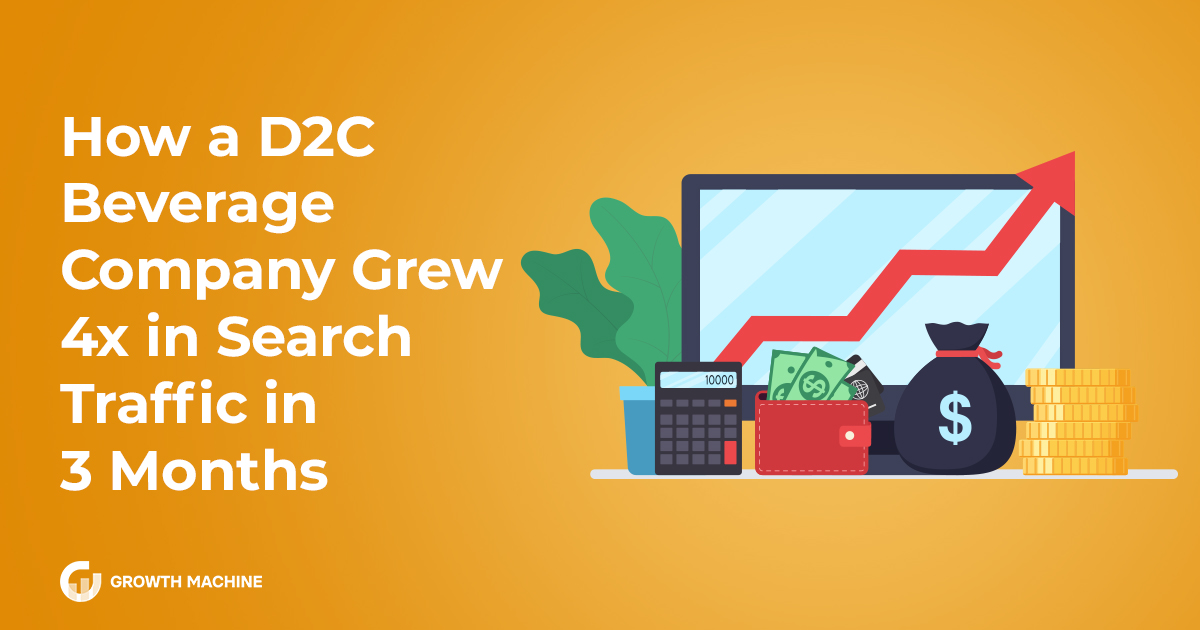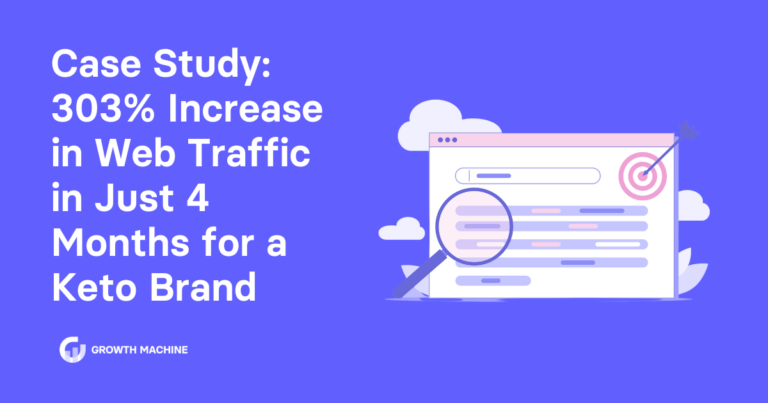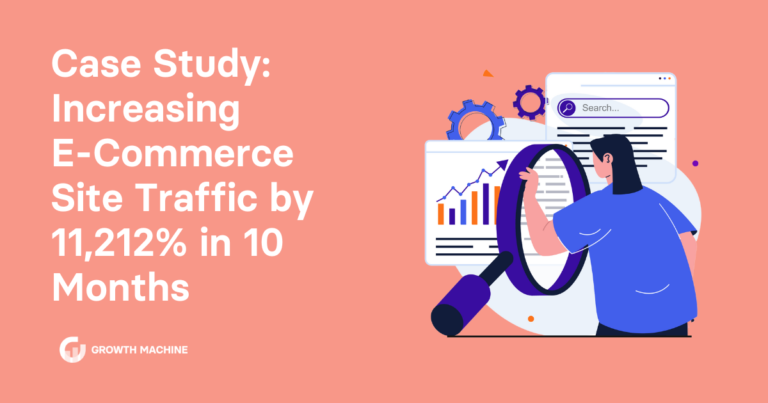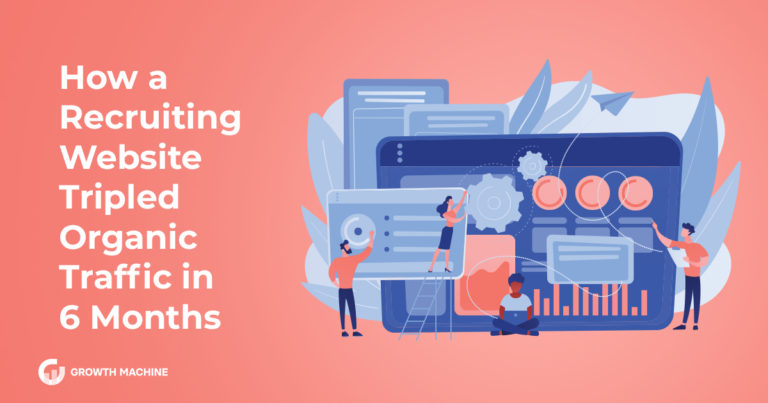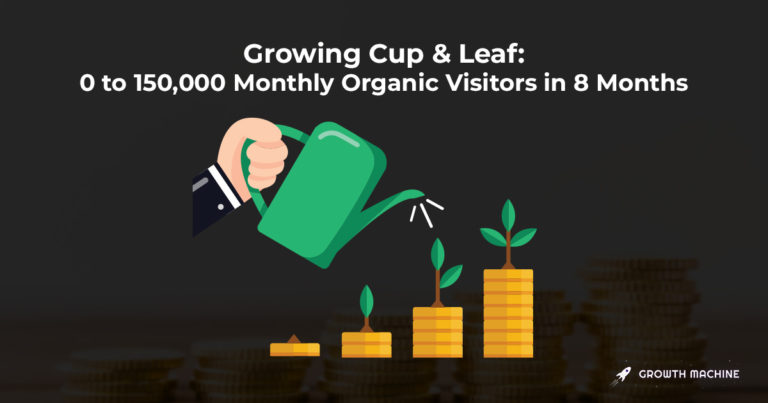How a D2C Beverage Company Grew 4x in Search Traffic in 3 Months
At first it was business as usual.
Within one month of working together, our direct-to-consumer alcoholic beverage client saw more organic traffic trickling in.
And then came a downpour.
By the third month of publishing keyword-optimized content, our client was getting 8,000 monthly organic visitors, or a 4x growth in search traffic from the time we started working with them.
By the sixth month, traffic had grown 8x.
The traffic has only continued to skyrocket from there. We consistently reach weekly record highs. As we publish this case study near our eighth month of working together, our client’s traffic has grown to 22,000 monthly organic sessions.
And it’s not just traffic. Our client is able to attribute more than $1,000 in revenue per month to a single blog post’s organic traffic.
Before we started working with this alcoholic beverage company, we worried whether alcohol-related content was a saturated space. But as it turned out, there wasn’t a lot of content providing information about alcoholic beverages in a friendly and accessible way. Most of the content already out there mostly catered to experts and connoisseurs.
The key to unlocking SEO success was creating a lot of helpful content for consumers in their market. Read on to learn how we did that, how we dominated the space, and how we boosted conversion rates.
Pinpointing a Niche to Unlock SEO Success
Our client had a clear sense of what they wanted: a content strategy to support their goal of being known for their alcoholic beverage content geared towards health-conscious people.
It was up to us to steer that ship. So we dove into our keyword strategy and advised on where to start. We created an editorial calendar and began creating the content.
The reason we were successful is that we had a well-defined niche to work in while still having room for growth. One of the most common content mistakes is when brands assume that writing about broad topics will reach the broadest audience. But the problem with that approach is it doesn’t consider how difficult it is to rank for those broad topics. And it doesn’t tie content strategy to what is unique about the company’s product offering.
Our client wasn’t trying to rank for “alcohol” in general. They sell a certain type of beverage, and they sell it to a health-conscious audience. We started fleshing out our content strategy based on key terms they wanted to rank for, and mapping out additional topics to educate their target audience, capture the traffic, and build trust.
Taking an education-focused approach helped us identify a keyword strategy that would move the needle.
We estimated it would take about six months to start ranking for keywords. After all, that’s the inflection point of reaching the Critical Authority Threshold. But we hit the milestones a lot faster.
Before the client signed us on, their organic visits were roughly 500 per week, or 2,000 per month. We started ranking for our target keyword terms immediately, and organic traffic grew faster than expected. We had kicked off our content strategy with lower difficulty keywords, and we made sure the content was easy to read. Most of the existing competing alcohol-related content was academic, so we focused on accessibility.
At three months, we got to ~8,000 monthly organic visitors, which continued to increase at a rapid pace. It was around this time that we added link building to their program, which helped to further build their domain authority.
By the six-month mark, we got to 16,000 monthly visitors. Today, we are 10 months in and we consistently reach new weekly highs. In fact, in October 2020, we surpassed 20,000 monthly organic visitors.

Creating Evergreen Content — in a Timely Way
We started to work with this client about one month before shelter-in-place orders were issued in the U.S. With most people staying at home, it may come as no surprise that American alcohol consumption began to rise. A recent Nielson report showed that at-home drinking increased by nearly one-third.
So with alcohol on the brain, this could have been the perfect opportunity to create quarantine-related content, right?
Not exactly.
Our content wasn’t successful because it included the pandemic in our keyword strategy. It was successful because we were thoughtful about how the current context and consumer needs would influence search volume and intent.
The stay-at-home orders meant that while people were looking to read about alcohol, they weren’t looking for content about going out for wine tastings or pub crawls, or hosting big parties. We focused on creating the content they were already seeking.
One of our Directors of Client Strategy, Gedaly Guberek, explains it best: “Ranking well on search is about giving people the best solution to a problem, question, or curiosity. With our content plan, we wanted to allow readers to discover solutions and ideas through enjoying this beverage.”
So, we filled the editorial calendar with evergreen content and wrote it through the lens of staying at home. This included posts about cooking with alcohol, storing alcohol, and stain removal — all relevant examples of content that people would want not only now, but also months or years from now.
Content Marketing as One Piece in the Sales Puzzle
Our client also leveraged content marketing as one piece in the overall sales and marketing puzzle.
They weren’t hoping content would solve all their problems. They didn’t expect every single blog post to convert.
They used the blog as a top-of-the-funnel channel to provide education, and generate brand and product awareness. And when it comes to premium products, content, and non-commodity businesses, education is often the best choice in content strategy. It’s a long-term play, and for this client, it also happened to work in the short term.
They then used paid advertising and retargeting to market their products to readers. Their organic content and paid marketing efforts worked hand in hand. Higher search rankings meant more unique visitors to their website, which meant more people to retarget in advertising, and more potential customers.
A Two-Pronged Approach: Bringing in Leads and Converting Them Into Customers
Our focus on growing organic traffic for our client meant that we began our content strategy with shorter-tail, higher-volume keywords that would increase our client’s search ranking. We identified keywords within their niche that also had more than 500 searches per month.
We also factored in long-tail keywords, and conversion-focused keywords that were more specific to their products’ uniqueness. It’s these keywords that have led to increased sales.
We wrote a blog post that describes the client’s product differentiator, a key ingredient of their beverage. This post speaks to all the reader’s (or potential customer’s) pain points regarding this ingredient:
- Why consumers might look for a beverage with or without this ingredient
- What qualities to look for in a company when you’re searching for a beverage with or without this ingredient
- An overview of some common available options
The post frames the topic in a way that is educational and informative, not salesy. It provides all the relevant information a person needs to make a buying decision.
The result of this post? More than $5,000 in revenue in five months. All from organic search.
What Can This Mean for You?
If you’re thinking about how growing your organic traffic can boost your overall sales, be sure to consider the following:
- What is your niche and how does your product support it?
- How can you create evergreen content in a way that is also timely?
- How can you leverage your increased website visibility and the content you’re creating in the rest of your marketing efforts?
- How can you guide users’ buying decisions by providing unique and helpful insights?
Of course, if you’re looking for an agency to do all this for you, you can always reach out to us.

